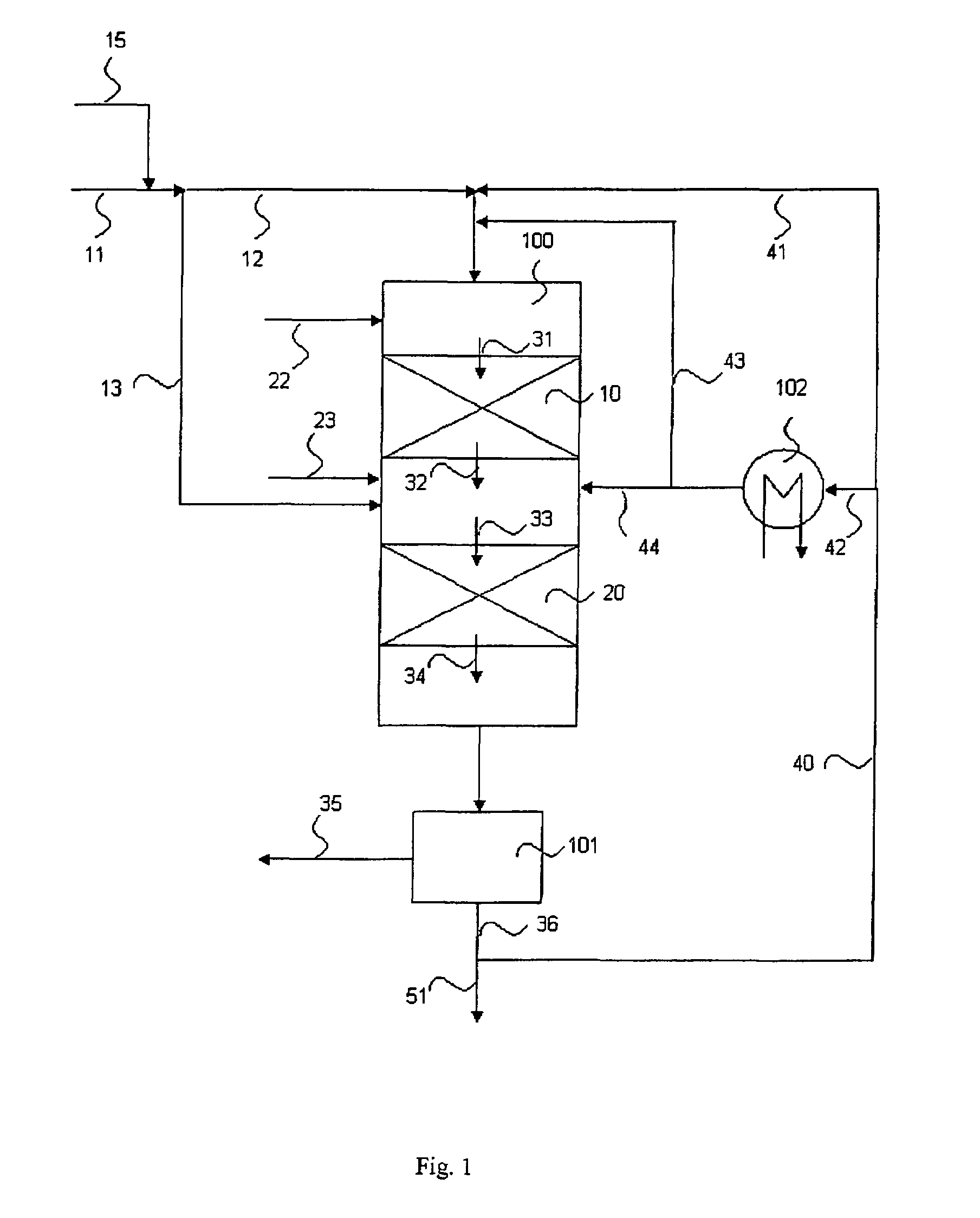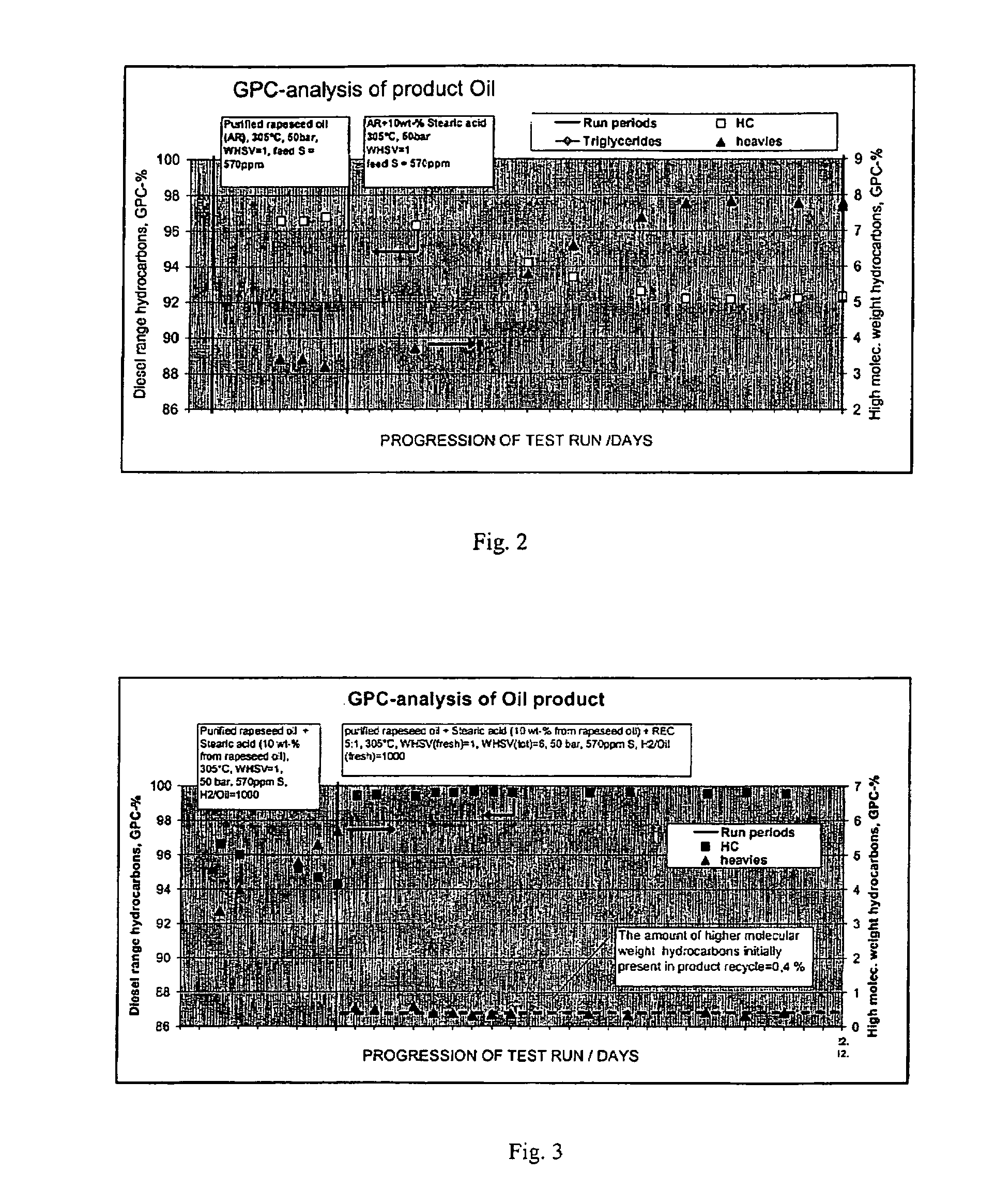Process for the manufacture of diesel range hydrocarbons
a hydrocarbon and diesel technology, applied in the field of improvement, can solve the problems of poor low-temperature properties of fame, limited use of transportation fuels, poor hydrocarbon properties, etc., and achieve the effects of reducing the formation of higher molecular weight compounds, reducing the operation temperature, and reducing the extent of side reactions
- Summary
- Abstract
- Description
- Claims
- Application Information
AI Technical Summary
Benefits of technology
Problems solved by technology
Method used
Image
Examples
example 1
Comparative Example
Tall Oil Feed (100% Free Fatty Acids) without Product Recycle
[0085]Hydrotreating of tall oil (100% free fatty acids) with NiMo catalyst was carried out at 50 bars pressure, LHSV 1.5 and reaction temperatures from 340-360° C. without product recycle. Hydrogen oil ratio was 900 normal liters H2 per liter oil fed. The hydrotreating of tall oil 100% free fatty acid feed caused rapid deactivation of NiMo catalyst, and formation of heavy weight compounds and aromatics was observed. Bromine indexes increased during the run even if temperature compensation of catalyst was used (FIG. 8). Product oil contained about 7 wt-% aromatics and about 7 wt-% heavies (>375° C. boiling). Density (50° C.) of product oil was high 777.1 kg / m3 compared to typical values with rapeseed oil hydrotreated product oil (761-762 kg / m3) using lower reaction temperature and optimized reaction conditions.
example 2
Comparative Example
Tall Oil Fatty Acid Feed (100% FFA) at High Reaction Temperatures without Product Recycle
[0086]Hydrotreating of tall oil fatty acid feed (100% FFA) at high reaction temperatures 370-385° C. was carried out without product recycle. Rapid deactivation of NiMo catalyst and formation of heavy weight compounds and aromatics was observed. Density of hydrotreated oil (table 1) was significantly higher than in rapeseed oil runs (typically 761-762 kg / m3). Both oils contained mainly C18 fatty acids (˜90-wt-%) and rather steady formation of water was observed during run. During the tall oil hydrotreating about 7-8 wt-% heavier molecular weight compounds and 8.1 wt-% aromatics were formed. These side reactions are caused by concentrated fatty acid feed and too high reaction temperatures. Deactivation of catalyst is clearly seen from increasing bromine indexes. During the satisfactory operation bromine index should be below 50. Table 1 describes densities, bromine indexes, rea...
example 3
Comparative Example
Effect of Metal Impurities of Bio Oils on the Catalyst Performance
[0088]Tube reactor hydrotreatment test runs were carried out using crude rapeseed oil, crude animal fat and purified rapeseed oil. Analysis of these feeds are shown in Table 2. Crude feeds contained significant amount of metals, organic phosphorus, sulphur and nitrogen compounds. Purified feeds contained only trace levels of these impurities
[0089]
TABLE 2Impurity levels of crude and purified plant oils and animal fatsCrudePurifiedCrudeRapeseedRapeseedAnimalImpurityUnitoiloilfatMetals (total)ppm90~0162Org. nitrogenppm337.21125Free Fatty acid, GPCWt-%0.80.710.8Total Acid Numbermg KOH / g1.00.121.5Phosphorousppm11086Sulphur (original)ppm3185
[0090]Test runs using crude, unpurified oils / fats showed that catalyst needed higher temperatures to work properly, but gradually lost its activity (FIG. 5). Triglycerides and increased bromine number of product oil was found. High amount of metals were also detected o...
PUM
| Property | Measurement | Unit |
|---|---|---|
| temperature | aaaaa | aaaaa |
| pressure | aaaaa | aaaaa |
| temperature | aaaaa | aaaaa |
Abstract
Description
Claims
Application Information
 Login to View More
Login to View More - R&D
- Intellectual Property
- Life Sciences
- Materials
- Tech Scout
- Unparalleled Data Quality
- Higher Quality Content
- 60% Fewer Hallucinations
Browse by: Latest US Patents, China's latest patents, Technical Efficacy Thesaurus, Application Domain, Technology Topic, Popular Technical Reports.
© 2025 PatSnap. All rights reserved.Legal|Privacy policy|Modern Slavery Act Transparency Statement|Sitemap|About US| Contact US: help@patsnap.com



